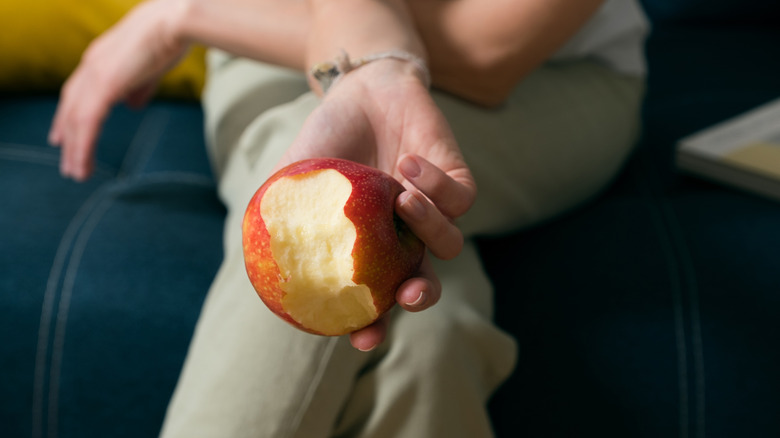Is There A Best Type Of Apple For Snacking? Here's What To Know
Whether you're in the produce section of the supermarket or visiting an orchard, you may be standing in a sea of apples and wondering which are the best. Well, that depends on what you're using them for. If you're looking for snacking specifically, some varieties work better than others. Food Republic spoke to Angela Graham, MBA, RDN, of The Dispersed Dietitian, to find out more.
According to Graham, "The best snacking apples tend to strike a balance between sweetness, tartness, and a satisfying crunch." While you can enjoy one of these while on the go, snacking apples also hold up well to being sliced and added to a lunchbox or paired with your favorite nut butters or cheeses. Her favorite is Honeycrisp, a beloved apple that's been consistently rising in consumer demand over the last two decades. "It's juicy, sweet, and incredibly crisp without being mealy." In season in autumn, it's the perfect choice for apple picking at an orchard — but you could also grab Jonagolds and Galas, both of which are crisp and lightly sweet.
With that said, there are other varieties that hit these same three marks. "Pink Lady apples, also known as Cripps Pink, ... lean slightly tart, but their crisp texture and bright flavor make them refreshing and snack-worthy." In the late summer, Graham recommends either Zestar or Ginger Gold as great early-season apples, but we also love Akane and Paula Red, which are tart but crispy.
She's also a fan of SweeTango, a hybrid between Honeycrisp and Zestar. This apple "delivers a bold crunch with sweet and tangy notes that pop when eaten fresh."
How to choose (and store) the best snacking apples
Whether you're apple picking at an orchard, farmer's market, or a supermarket, there are some strategies to choose the best ones. One of our favorites is to check for firmness. Give it a little squeeze — if it's firm to the touch, you should be good to go, but if it indents easily, is soft or mushy in areas, or has any brown spotting, it's best to leave it behind. "A crunchy apple signals freshness and is far more satisfying to eat than one with soft or mealy flesh," Angela Graham said. Additionally, you can check the apple for color. A full-colored apple is an indicator that it's flavorful — if the apple is meant to be red, it should be fully (or mostly) red rather than partly green. A final way to pick sweeter apples is to check out the stem. A brown stem (rather than a green one) indicates that the apple has matured.
To keep apples fresh, avoid storing them in your fruit bowl. Instead, Graham recommended storing them in the crisper drawer of your fridge. "Apples release ethylene gas, which speeds up ripening in other produce, so it's best to store them separately when you can." Another method that works surprisingly well is to wrap them individually in newspapers and keep them in a cool, dry place, like the pantry. When stored correctly, your apples can last up to (and beyond!) six weeks. Otherwise, putting them in a brown paper bag in the crisper drawer keeps them fresh (and protects other produce, too).
Varieties that work well in the kitchen
While enjoying apples as a snack is one way to use them, it's no secret that you may also be looking for ones to use in cooking or baking. When it comes to baking, Angela Graham noted that Granny Smith is a fan favorite thanks to its firm texture that holds up well to heat, but also its tartness balances out the added sugars in baked goods. This is why it's known as one of the best apples for apple pie. Other ones that are great for baking include varieties like Braeburn, Gala, and Fuji. Graham noted in particular that Cortland apples are "often used in pies or baked goods for their ability to stay intact, but their flavor can be pretty mild when eaten raw." To strike a balance, consider using multiple varieties in your baking, as the mix of sweet and tart baking-friendly apples can deliver a nice depth of flavor in the final product.
She also suggested McIntosh apples as a variety that does well when cooked down instead, since these apples have a softer texture that won't hold well in pies. "They're great for applesauce because they break down easily, but that same quality makes them too soft for snacking unless you like a more tender texture," Graham said. Other apples that work well for cooking down are Golden Delicious and Stayman.



